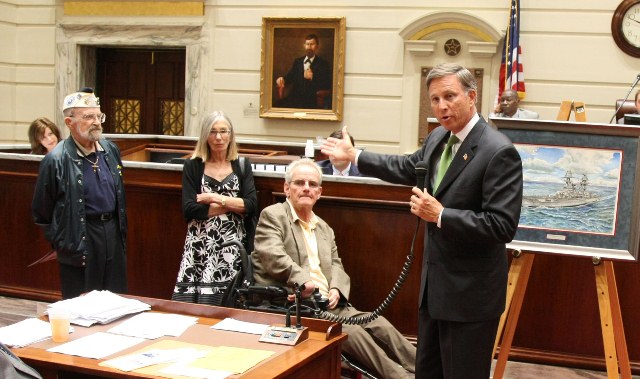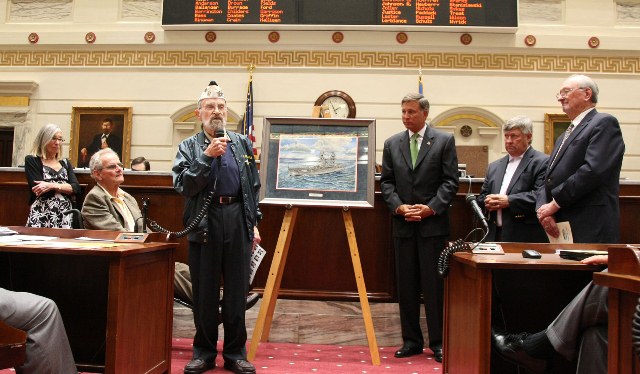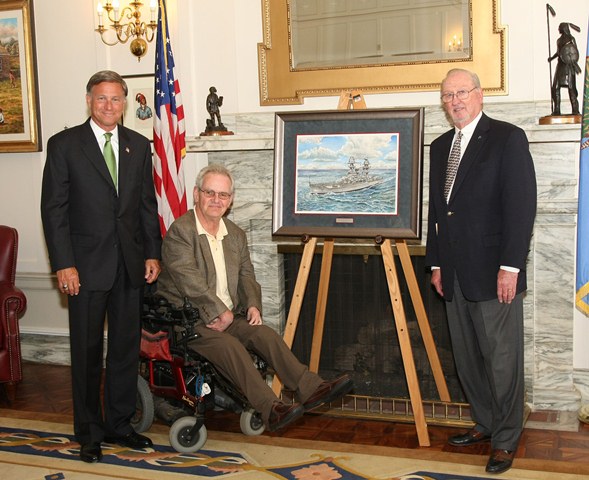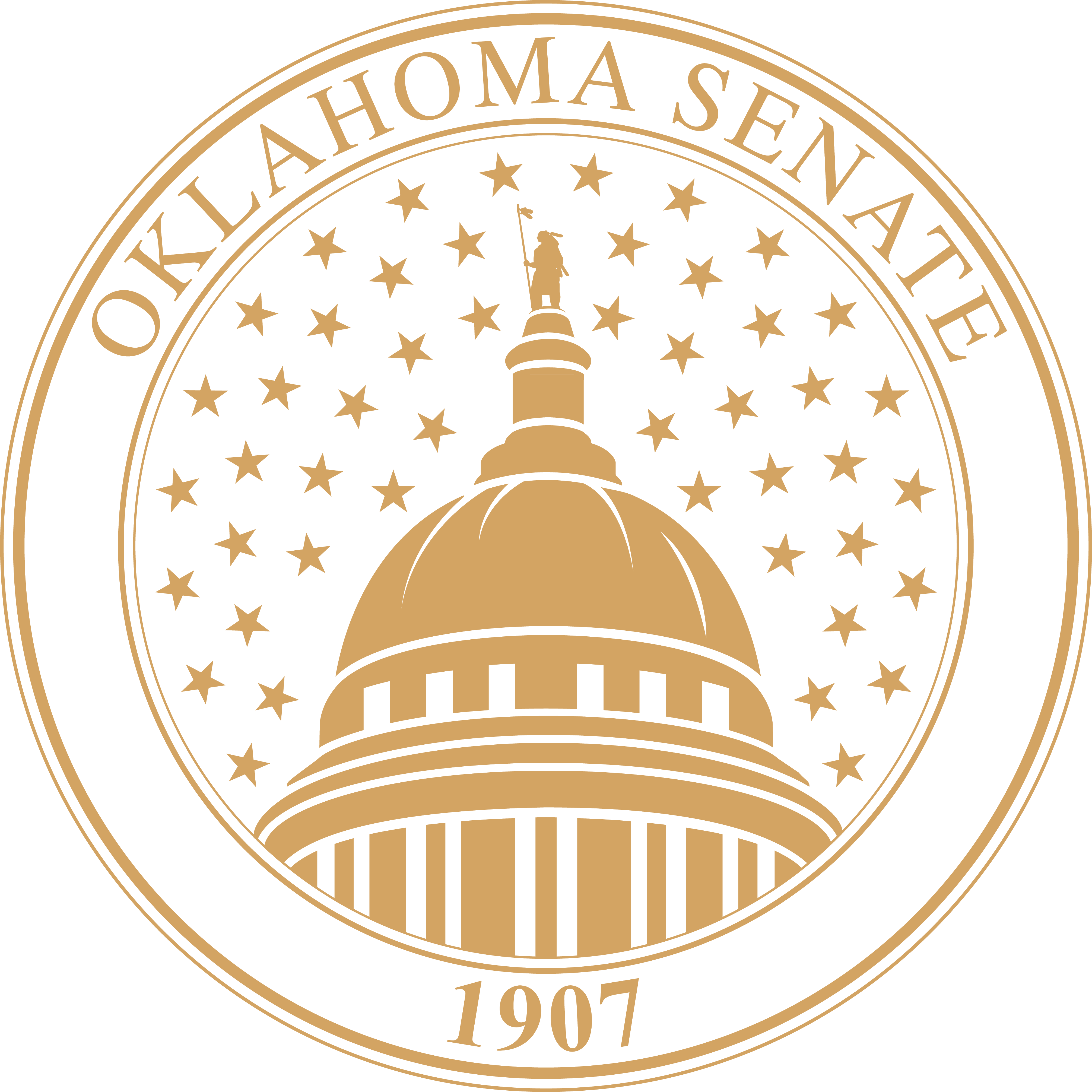“U.S.S Oklahoma at Sea” dedicated by Senate
 Retired US Navy Admiral Greg Slavonic addresses the Senate.
Retired US Navy Admiral Greg Slavonic addresses the Senate.
 USS Oklahoma survivor Ed Veazey speaks to Senate
USS Oklahoma survivor Ed Veazey speaks to Senate
 Retired Adm Slavonic, artist Greg Burns and Fund President Charles Ford
Retired Adm Slavonic, artist Greg Burns and Fund President Charles Ford
The Senate dedicated a painting Tuesday of the famous U.S.S Oklahoma Navy battle ship. The painting was both created and sponsored by Oklahoma artist Greg Burns in cooperation with the U.S.S. Oklahoma Memorial at Pearl Harbor Executive Committee. Committee co-chairs retired Rear Admiral Greg Slavonic, USN, and retired Commander Tucker McHugh, USN attended the event with U.S.S. Oklahoma surviving crewmember Ed Vezey.
“There was no memorial at Pearl Harbor for the battleship Oklahoma so for 66 years the great State of Oklahoma had no representation so Commander McHugh and I got together and we did this for two reasons – to recognize our namesake battleship and to recognize the crewmember who served aboard that battleship,” said Slavonic. “We needed to find a fitting home for this painting and felt the Capitol was the best place to put it; and thanks to Senator Ford, he made this happen for us.”
When Adm. Slavonic and Cmdr. McHugh were raising money for the U.S.S Oklahoma memorial, Burns told them he would do a print of the battleship and then they could make lithographs and sell them to raise additional funds.
“When I heard what they were doing, I really wanted to do a painting of the battleship. In the process of going through the photographs and getting all the details it was amazing. Unfortunately, I had to use a lot of the devastating photographs that were taken after the attack, but it’s amazing the bravery and the sacrifice,” said Burns. “It’s an extreme honor for me to have my painting here in the Capitol with all of this other incredibly beautiful artwork.”
The USS Oklahoma (BB-37), the only ship of the U.S. Navy to ever be named for the 46th state, was a World War I era battleship and the second of two ships in her class; her sister ship was Nevada (BB-36). She, along with her sister, were the first two U.S. warships to use oil fuel instead of coal.
Commissioned in 1916, the Oklahoma served in World War I as a member of Battleship Division protecting Allied convoys on their way across the Atlantic.
After years of spending time in the Pacific and the Scouting Fleets, the Oklahoma was modernized from 1927 to 1929. She rescued American citizens and refugees from the Spanish Civil War in 1936. Then after returning to the West coast in August of that year, she spent the rest of her life in the Pacific.
The U.S.S Oklahoma is most notable for her involvement in Pearl Harbor. She was sunk by Japanese bombs and torpedoes on December 7, 1941, in the attack on Pearl Harbor, taking 429 of her crew with her as she capsized.
Vezey thanked Adm. Slavonic, Cmdr. McHugh and Burns for their dedication to preserving the memory of the U.S.S. Oklahoma and her crew.
“You’re part of building a set of memories that would not exist without your work. Memories are very important. As you grow older you realize how important,” said Vezey. “A wise man once said ‘you can’t possibly understand a person or a country unless you know their memories’. And this is all a part of establishing and maintaining some memories. The reason I’m still involved is because the memories can slip away and the basis for which we live can slip away very easily.”
The 91-year-old continued by recounting memories of the ship.
“It’s hard many times to come see that beautiful ship. People don’t realize the bonding that there is between the crew and the ship.” Recounting one of the nights he was on watch, he came to a realization, “I stopped a minute and I said ‘you stupid idiot, you’re in love with this bunch of iron and steel’. And you are because it’s your home, it’s your mother, it’s your haven.”
Vezey concluded by thanking those who helped make the U.S.S. Oklahoma Memorial possible.
“It’s a wonderful ship, a wonderful state. Greg [Slavonic] and Tucker [McHugh] pulled together about three years of extremely hard work and got a memorial built at Pearl; and believe me, the state of Oklahoma rose as one person. You wouldn’t believe how much people got involved. People ask me why I live in Oklahoma. It’s because of the people, the wonderful people of Oklahoma who are now very much a part of my memory,” said Vezey. “Just remember you are part of our building more memories now that will sustain me until the Lord calls me home and I hope will be passed along to the next generation.”
The USS Oklahoma was uprighted in 1943, but unlike most of the other battleships damaged in Pearl Harbor, she was never repaired and returned to duty. Instead, the ship was stripped of her gun and superstructure, and sold for scrap. She sank while under tow to the mainland in 1947.
Artist Greg Burns is featured throughout the country and world. He earned a bachelor of Fine Arts from Oklahoma University in 1971. He works in ink and watercolor, drawing the intricate detail with a pen first and following with watercolor. Burns is well known for his prints of Oklahoma schools, universities and landmarks. Born with Arthrogryposis, a muscle and joint disease which affects the use of his arms and legs, he draws with the pen in his hand and adds watercolor by holding the brush in his teeth.
 Oklahoma Senate
Oklahoma Senate

